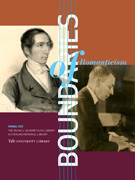
It’s customary to describe the history of western art music as a progression of historical periods: Medieval, Renaissance, Baroque, Classical, Romantic, and Modern. These periods form the basis of countless books, recordings, courses, radio programs, and so on. But they are the creation of historians and critics, not a depiction of the natural order of things. They are useful fictions that help us take the disorderly and contradictory sources that have come down to us, and turn them into a coherent story. If the boundary lines were drawn in different places, we might have different stories. In Boundaries of Romanticism, we highlight composers who stand (chronologically or stylistically) near the beginning or the end of the Romantic era. These include Beethoven, Schubert, Mendelssohn, Mahler, Richard Strauss, Rachmaninoff, and others. Each composer is represented by a musical manuscript, letter, or other item, such as an Austrian coin bearing Schubert’s likeness, or a program of a concert that Mahler conducted in Woolsey Hall.
Boundaries of Romanticism is one of three related exhibits at Yale in 2015; the others are The Critique of Reason: Romantic Art, 1760-1860 at the Yale University Art Gallery, and ‘Illuminated Printing’: William Blake and the Book Arts at the Haas Family Arts Library.